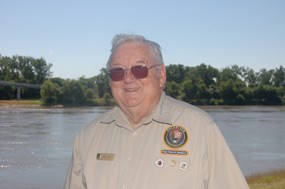
and Clark Trail Heritage Foundation. Dr. Camp is also a member of the editorial review board for “We Proceeded On”, the quarterly journal published by the Found NPS-Sigala "Seaman: Captain Lewis's Canine Voyageur"
Arguably, Captain Meriwether Lewis's four-footed companion, a
In his first journal entry, Lewis said this about his long-delayed departure from Pittsburgh as be began his historic journey: "Left Pittsburgh this day [August 31, 1803] at 11 ock [o'clock] with a party of 11 hands 7 of which are soldiers, a pilot and three young men on trial they having proposed to go with me throughout the voyage." That's it; there's no mention of a dog being aboard.
Indeed, Lewis did not acknowledge the presence of his dog until September 11th, when he had been underway almost two weeks. On that date he wrote: "…observed a number of squirrels swiming [sic] the Ohio and universally passing from the W. to the East shore…I made my dog take as many each day as I had occation for, they wer fat and I thought them when fryed a pleasent food…my dog was of the newfoundland breed very active strong and docile, he would take the squirel in the water kill them and swiming bring them in his mouth to the boat." This is only the first of numerous subsequent mentions of the dog's hunting prowess.
From that time onward when the canine voyageur was mentioned in Lewis's journal entries it was as "my dog," rarely by name. When mentioned by William Clark, or one of the other journal-keepers, he was usually "Captain Lewis's dog" or "the dog." As time wore on and Seaman established himself as a valued member of the expedition, Clark and the men began referring to him as "our dog."
Lewis conveyed a little more information about "his dog" when the Corps of Discovery stopped on November 16th at the junction of the
The dog's name has been the subject of some debate over the years since the original journals were published in their entirety by Thwaites. It's either Seaman or Scannon, depending on the vintage of the journals one happens to consult. Since 1985, or thereabout, Seaman seems to have won out. But that's another story for another day.
H. Carl Camp, Ph.D.
|
Last updated: April 10, 2015
